
Friendship Hill was the home of early American politician and statesman Albert Gallatin (1761–1849). Gallatin was a U.S. Congressman, the longest-serving Secretary of the Treasury under two presidents, and ambassador to France and Great Britain. The house overlooks the Monongahela River near Point Marion, Pennsylvania, about 50 miles (80 km) south of Pittsburgh.
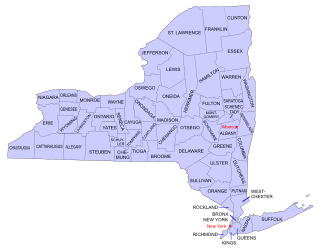
Buildings, sites, districts, and objects in New York listed on the National Register of Historic Places:

The Clinton House is an 18th-century Georgian stone building in the city of Poughkeepsie, Dutchess County, New York, United States. It is a New York State Historic Site and has been listed in the National Register of Historic Places as a historic place of local significance since 1982. The house was named for George Clinton, who served as the first Governor of New York and fourth Vice-President of the United States. He was believed to have lived there after the American Revolutionary War, but it is now known that it was never his residence.

1 Hanover Square is a commercial building on the southwestern edge of Hanover Square in the Financial District of Lower Manhattan in New York City. It was the site of the United States' first cotton futures exchange, the New York Cotton Exchange.

The Andrew Carnegie Mansion is a historic house located at 2 East 91st Street at Fifth Avenue in the Upper East Side of Manhattan, New York City, New York. Andrew Carnegie moved into his newly completed mansion in late 1902 and lived there until his death in 1919; his wife, Louise, continued to live there until her death in 1946. The building is now the Cooper-Hewitt, Smithsonian Design Museum, part of the Smithsonian Institution. The surrounding area, part of the larger Upper East Side neighborhood, has come to be called Carnegie Hill. The mansion was named a National Historic Landmark in 1966.
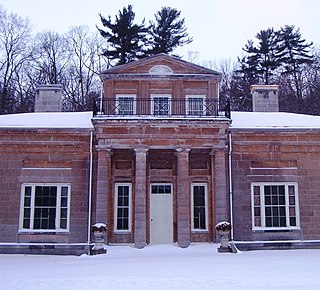
Hyde Hall is a neoclassical country mansion designed by architect Philip Hooker for George Clarke (1768–1835), a wealthy landowner. The house was constructed between 1817 and 1834, and designed with English and American architectural features. It was designated a National Historic Landmark in 1986 for its architecture, and the completeness of its architectural documentary record. It is one of the few surviving works of Philip Hooker, a leading 19th-century American architect.

The Senate House State Historic Site is located on Fair Street in Kingston, New York, United States. During the Revolutionary War, New York's First Constitutional Convention met there and on April 20, 1777, adopted the first New York State Constitution. After one month, the Senate fled the British troops who were advancing from Manhattan. The Senate House and much of Kingston was burned in retribution. It has served as a museum from the late 19th century. Currently it is owned and operated by the New York State Office of Parks, Recreation and Historic Preservation.

Stone Street is a short street in the Financial District of Manhattan in New York City. It runs in two sections between Whitehall Street in the west and Hanover Square in the east. The street originally ran as one continuous roadway from Whitehall Street to Hanover Square, but the section between Broad Street and Coenties Alley was eliminated in 1980 to make way for the Goldman Sachs building at 85 Broad Street. The one-block-long western section between Whitehall and Broad Streets carries vehicular traffic, while the two-block-long eastern section between Coenties Alley and Hanover Square is a pedestrian zone.

Davis Stone House is a historic home located at Rochester in Ulster County, New York. It includes the house, small barn, and silo. The stone house is linear in plan with a perpendicular frame extension off the rear. The main stone section is one and one half stories, five bays wide with a central entrance, and pent roof.
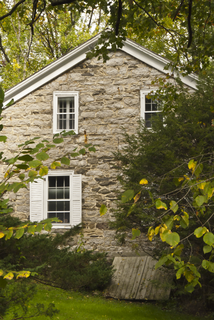
Sahler Stone House and Dutch Barn is a historic home and Dutch barn located at Rochester in Ulster County, New York. The house was built about 1780 and is a five-bay, 1 1⁄2-story linear plan stone and frame gable ended house. It was restored in 1957. The 1-story Dutch barn has a corrugated metal roof and clapboard siding.

J. Sahler House, also known as Elm Rock, is a historic home located at Rochester in Ulster County, New York. It is a 1 1⁄2-story, Federal-style brick house built about 1807. Also on the property is a small barn.
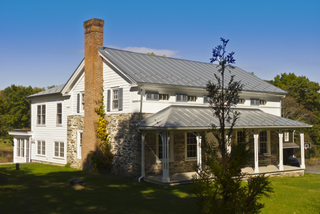
Stilwell-Westbrook Stone House is a historic home located at Rochester in Ulster County, New York. It is a 1 1⁄2-story, five-bay stone dwelling built about 1750. Changes in the early 19th century added Greek Revival details. Also on the property is a large privy dated to about 1880.
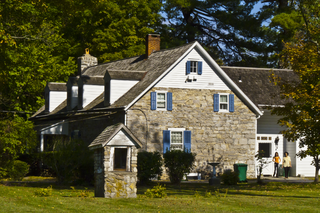
Jacobus Van Wagenen Stone House is a historic home located at Rochester in Ulster County, New York. It is a traditional 1 1⁄2-story stone, gable-roofed house built about 1751.

Winfield Corners Stone House is a historic home located at Rochester in Ulster County, New York. It is a 1 1⁄2-story, field stone house that is linear in plan with frame additions. It was built about 1732. The main house block has a central cross gable with a pair of flanking gable dormers.

Krom Stone House and Dutch Barn is a historic home and Dutch barn located at Rochester in Ulster County, New York. The property includes the stone house, Dutch barn, and shed. The main block of the house is a 1 1⁄2-story stone dwelling in a linear plan. In 1966, the stone was covered in stucco.

Miller Homestead is a historic home located at Au Sable in Clinton County, New York. The house was built in 1822 and is a 1 1⁄2-story stone dwelling. It is a five-by-two-bay, side-gabled Federal-style structure. Also on the property is the foundation remains of a large 19th-century barn and a stone wall. It is open as a local history museum.

The William H. Moore House, also known as the Stokes-Moore Mansion and once home to the America-Israel Cultural Foundation, is a historic building located in New York, New York. The building was designed by the architecture firm McKim, Mead & White and built between 1898 and 1900. It is a five-story, rectangular stone building in the Renaissance Revival style. It has an English basement and flat roof with balustrade and overhanging cornice. It was commissioned by William Earle Dodge Stokes (1852–1926), and purchased by financier William Henry Moore (1848-1923) before its completion. His wife resided in the house until her death in 1955, after which it housed a succession of commercial and charitable organizations, including the Banco di Napoli.
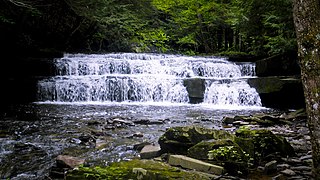
Christman Bird and Wildlife Sanctuary is a national historic district located near Delanson, Schenectady County, New York. The district includes six contributing buildings and one contributing structure on a largely wooded, rural 105-acre (42 ha) tract. It lies in the valley of the Bozenkill and includes a 30-foot (9.1 m) waterfall along the Helderberg Escarpment. Located on the property is a two-story frame dwelling built in 1868, a stone dairy house, barns, large stone walls, and an open lean-to built by the Mohawk Valley Hiking Club. The sanctuary had its beginnings in 1888 when property owner W.W. Christman (1865-1937) and his wife, the former Catherine Bradt, began a winter bird feeding program during the great blizzard of that year.

The Keeper's House at Williamsbridge Reservoir is a historic home located in the Borough of the Bronx in New York City. It was built in 1889 as part of the Williamsbridge Reservoir complex. It is a 2 1⁄2-story, L-shaped stone house. The stones used to build the house were pieces of granite taken from the excavation of the reservoir it was to serve. It is 5,000 square feet (460 m2) in size and has a slate-covered gable roof with a clay tile roof ridge and copper gutters.




















